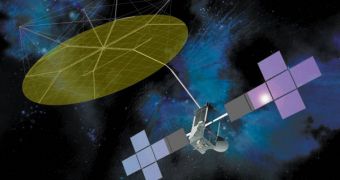TerreStar Network (TSN) announced that its largest satellite yet, the TerreStar-1, had been safely delivered to the Kourou Space Center, in the French Guyana, South America. The instrument, which is the largest satellite ever constructed and scheduled to be deployed, is planned to lift off from the European Space Agency's (ESA) facility on June 24th, and will be carried into orbit aboard the “workhorse” of the agency, the Ariane 5 delivery system. TSN is a subsidiary of TerreStar Corporation and Space Systems/Loral.
“The arrival of TerreStar-1 signals the start of final launch preparations. Once launched, TerreStar-1 will allow us to deliver on the vision of an integrated satellite and terrestrial mobile service that enables next-generation applications anytime, anywhere,” the President of TerreStar Networks, Jeffrey Epstein, explained. The new observatory will provide integrated satellite and terrestrial mobile services for critical communications through the use of conventionally sized dual-mode handsets.
“The design, manufacture and delivery of TerreStar-1 has been a team effort. We have relied on our colleagues at Space Systems/Loral for their experience and support in delivering the integrated satellite and ground system that makes our new services possible. We now look forward to a flawless launch by our partner Arianespace,” the Chief Technology Officer from TerreStar Networks, Dennis Matheson, added. The aeronautics company Arianespace is responsible for handling preparations for all Ariane 5 missions lifting off from South America, and is also the main constructor of these vehicles.
“It has been a pleasure working with TerreStar Networks on this challenging project. With its 18-meter unfurlable reflector and extraordinarily powerful S-Band feed array, TerreStar-1 was designed to provide next-generation capability for mobile devices,” Space Systems/Loral President and Chief Operating Officer, John Celli, emphasized. The satellite will be able to provide quick response times for a host of mobile applications, and will cover the needs of emergency workers, government officials, and the civilian population very effectively, mission planners hope.
The satellite will mostly cover areas in the continental US, Canada, Alaska, Hawaii, Puerto Rico and the US Virgin Islands, and will provide numerous high-speed mobile applications for these regions. According to TSN, it will generate approximately 500 spot beams, which should ensure a wide range of services, even in areas that have thus far remained out of coverage. The capacity of the instrument is also boosted by the new revolutionary bandwidth allocation it employs, which allows it to distribute resources based on demand, and not by default.

 14 DAY TRIAL //
14 DAY TRIAL // 
